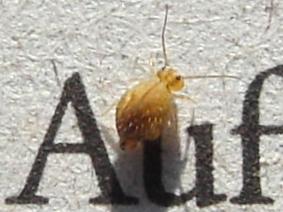|
Mackenziellidae
Mackenziellidae is a family of springtails belonging to the order Symphypleona The order Symphypleona is one of the three main groups of springtails (Collembola), tiny hexapods related to insects. When the springtails were still believed to be an order of insects, the Symphypleona were ranked as a suborder. They can be .... Genera Mackenziellidae includes the following genera: * '' Mackenziella'' Hammer, 1953 References Collembola Arthropod families {{Springtail-stub ... [...More Info...] [...Related Items...] OR: [Wikipedia] [Google] [Baidu] |
Symphypleona
The order Symphypleona is one of the three main groups of springtails (Collembola), tiny hexapods related to insects. When the springtails were still believed to be an order of insects, the Symphypleona were ranked as a suborder. They can be best distinguished from the other springtail groups by their body shape. The Symphypleona are very round animals, almost spherical, and usually have long antennae. The Poduromorpha, by contrast, always have short legs and a plump body, but more oval in shape than the Symphypleona. The Entomobryomorpha are the slimmest springtails, some with long and some with short legs and antennae, but always with a very slender body. Systematics The Symphypleona order was previously suggested to also contain family Neelidae, as a very apomorphic relative in the Sminthuridae superfamily. Phylogenetic studies however suggest Neelidae to be the only family of Neelipleona order.Gao, Yan; Bu, Yun & Luan, Yun-Xia (2008): Phylogenetic Relationships of Basa ... [...More Info...] [...Related Items...] OR: [Wikipedia] [Google] [Baidu] |
Springtails
Springtails (Collembola) form the largest of the three lineages of modern hexapods that are no longer considered insects (the other two are the Protura and Diplura). Although the three orders are sometimes grouped together in a class called Entognatha because they have internal mouthparts, they do not appear to be any more closely related to one another than they are to all insects, which have external mouthparts. Collembolans are omnivorous, free-living organisms that prefer moist conditions. They do not directly engage in the decomposition of organic matter, but contribute to it indirectly through the fragmentation of organic matter and the control of soil microbial communities. The word ''Collembola'' is from the ancient Greek "glue" and "peg"; this name was given due to the existence of the collophore, which was previously thought to stick to surfaces to stabilize the creature. Some DNA sequence studies suggest that Collembola represent a separate evolutionary line fro ... [...More Info...] [...Related Items...] OR: [Wikipedia] [Google] [Baidu] |
Collembola
Springtails (Collembola) form the largest of the three lineages of modern hexapods that are no longer considered insects (the other two are the Protura and Diplura). Although the three orders are sometimes grouped together in a class called Entognatha because they have internal mouthparts, they do not appear to be any more closely related to one another than they are to all insects, which have external mouthparts. Collembolans are omnivorous, free-living organisms that prefer moist conditions. They do not directly engage in the decomposition of organic matter, but contribute to it indirectly through the fragmentation of organic matter and the control of soil microbial communities. The word ''Collembola'' is from the ancient Greek "glue" and "peg"; this name was given due to the existence of the collophore, which was previously thought to stick to surfaces to stabilize the creature. Some DNA sequence studies suggest that Collembola represent a separate evolutionary line fro ... [...More Info...] [...Related Items...] OR: [Wikipedia] [Google] [Baidu] |


.jpg)